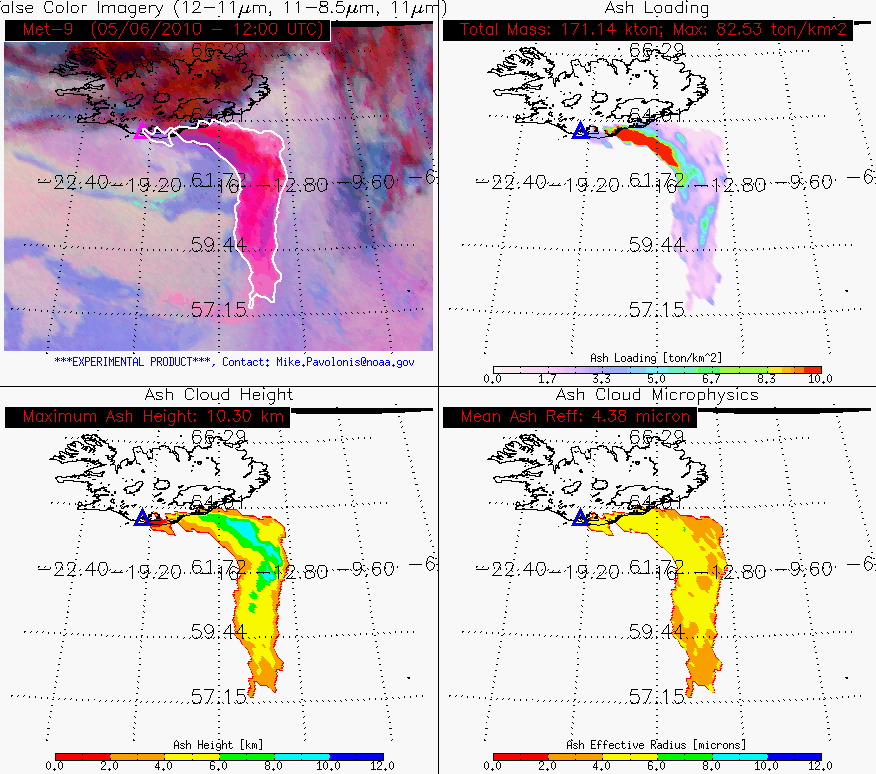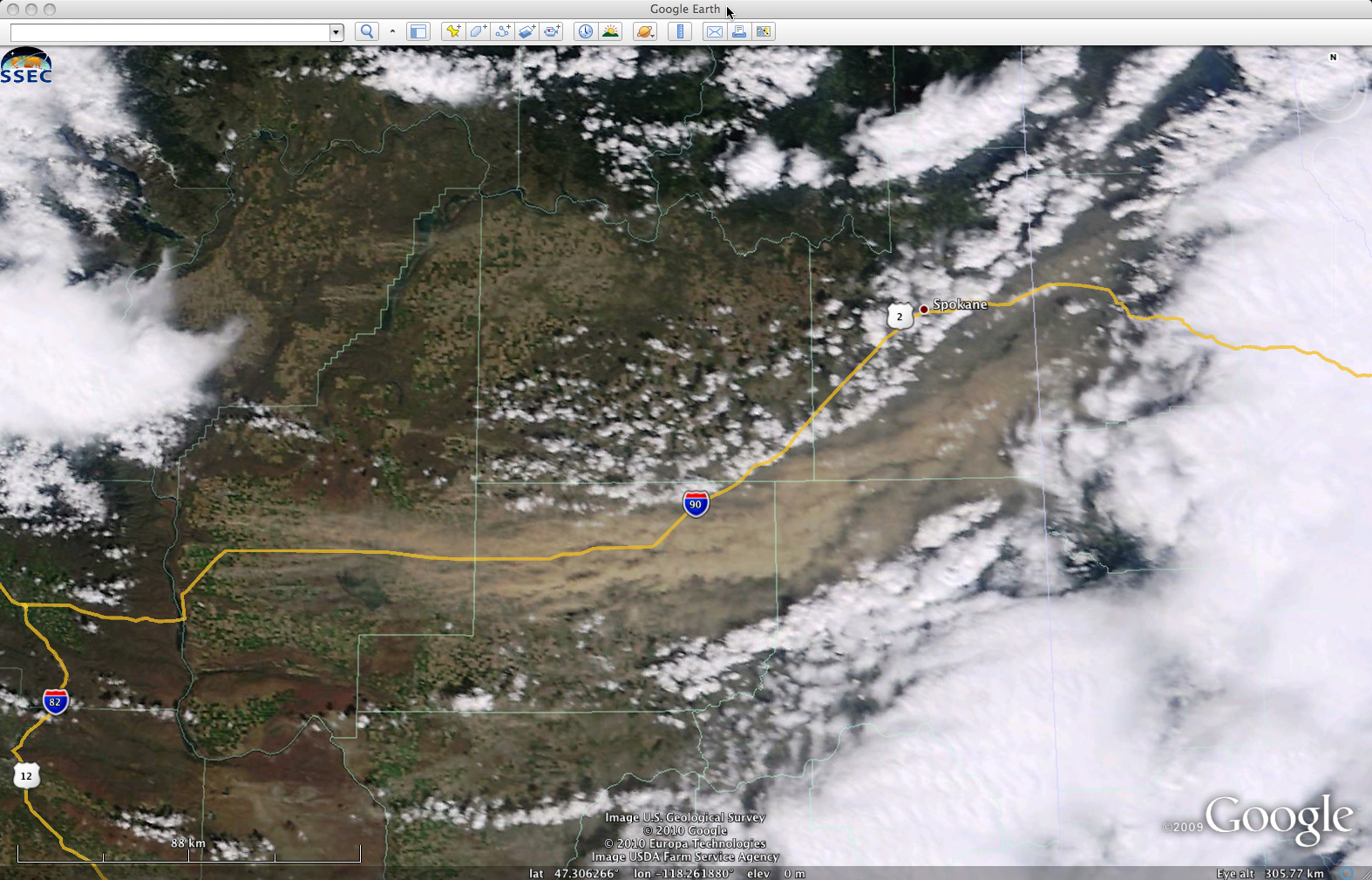 |
ASPB and CIMSS Weekly Report
[ Archive ] |
 |
ASPB AND CIMSS WEEKLY HIGHLIGHTS FOR THE WEEK ENDING MAY 8, 2010
IN THE PRESS:
NOAA/NESDIS/STAR and CIMSS Volcanic Research Featured
in Online Article: The volcanic ash products developed by
NOAA/NESDIS/STAR and the Cooperative Institute for Meteorological
Satellite Studies (CIMSS) were featured in a PhysOrg.com article, which
can be found at http://www.physorg.com/news192180936.html.
The STAR/CIMSS volcanic ash products were also highlighted in a
National Aeronautics and Space Administration (NASA) news release (http://www.nasa.gov/topics/earth/features/ash_plume.html).
(M. Pavolonis, E/RA2, 608-263-9597, Mike.Pavolonis@noaa.gov)
ITEMS FOR THE ADMINISTRATOR:
ITEMS FOR THE ASSISTANT ADMINISTRATOR:
ITEMS FOR THE OFFICE DIRECTOR, STAR:
VIIRS Operational Algorithm Team Meeting in Madison: The
Cooperative Institute for Meteorological Satellite Studies
(CIMSS)/Space Science and Engineering Center (SSEC) and the Advanced
Satellite Products Branch (ASPB) hosted the NPOESS Visible Infrared
Imager Radiometer Suite (VIIRS) Operational Algorithm Team (VOAT)
meeting at the University of Wisconsin-Madison, April 27-28, 2010.
Representatives from government and industry participated in the
meeting. A. Heidinger is the co-chair of the VOAT. (A. Heidinger, E/RA2,
608-263-6757, andrew.heidinger@noaa.gov)
Manuscript on Forecasting Typhoon Rapid Intensification Published: A
manuscript entitled "An improvement in forecasting rapid intensification
of Typhoon Sinlaku (2008) using clear-sky full spatial resolution IR
soundings" has been published in Journal of Applied Meteorology and
Climatology. Co-authors are Hui Liu (National Center for Atmospheric
Research - NCAR) and Jun Li (Cooperative Institute for Meteorological
Satellite Studies - CIMSS). (Jun Li, CIMSS, Jun.Li@ssec.wisc.edu,
608-262-3755)
ITEMS FOR THE DIVISION CHIEF, CoRP:
Suomi Scholarship Winners Selected:
In its twelfth year this May 2010, the “Verner E. Suomi Scholarship Award” has been won by two incoming college students showing outstanding achievement in the physical sciences. Both of this year’s winners, K. Williams (Hurley, WI) and B. Gjermo (Stillwater, MN), are planning to attend the University of Wisconsin-Madison (UW) and major in atmospheric sciences. The late Professor Suomi (1915-1995) was a world renowned researcher and educator at the UW Space Science and Engineering Center (SSEC) and the UW Department of Atmospheric and Oceanic Sciences, gaining tenure in 1948. He has often been called the “father of satellite meteorology” (http://library.ssec.wisc.edu/SuomiWebsite/index.html). (S. Ackerman, CIMSS, 608-263-3647, steve.ackerman@ssec.wisc.edu; T. Achtor, CIMSS, 608-263-4206 tom.achtor@ssec.wisc.edu; G. S. Wade, E/RA2, 608-263-4743, gary.s.wade@noaa.gov)
Monitoring of Eyjafjallajokull Volcanic Ash: The Eyjafjallajokull volcano in Iceland continued to erupt during the week of May 2, 2010, with significant ash emissions. Experimental STAR and Cooperative Institute for Meteorological Satellite Studies (CIMSS) volcanic ash products were made available to the London Volcanic Ash Advisory Center in near-realtime. The products are available on the web at http://cimss.ssec.wisc.edu/goes_r/proving-ground/geocat_ash/loops/iceland.html. In addition, the CIMSS Satellite Blog was updated with new imagery and products relevant to this week’s eruptions. (M. Pavolonis, E/RA2, 608-263-9597, Mike.Pavolonis@noaa.gov, S. Bachmeier, CIMSS, 608-263-3958, J. Sieglaff, CIMSS, 608-265-5357)
 (Click image to enlarge)
(Click image to enlarge)
Figure caption: The NOAA/NESDIS/STAR and Cooperative Institute for Meteorological Satellite Studies (CIMSS) volcanic ash products are shown for an eruption of Eyjafjallajokull, in Iceland, on May 6, 2010 at 12:00 UTC. A false color image (top left), the ash mass loading (top right), ash cloud height (bottom left), and ash particle size (bottom right) are displayed in the four panels.
CIMSS VISIT Activities: The Virtual Institute for Satellite Integration Training (VISIT) distance learning module "Interpreting Satellite Signatures" (http://rammb.cira.colostate.edu/visit/sat_signatures.html) was led by S. Lindstrom from the Cooperative Institute for Meteorological Satellite Studies (CIMSS) on May 5, 2010. Staff from the National Weather Service forecast office at Lubbock, Texas participated in the VISIT lesson. In addition, the CIMSS Satellite Blog was updated with a variety of satellite images covering such topics as the historic heavy rainfall event at Nashville, Tennessee on May 2, 2010 (http://cimss.ssec.wisc.edu/goes/blog/archives/5432), a major blowing dust event in the Pacific Northwest on May 3, 2010 (http://cimss.ssec.wisc.edu/goes/blog/archives/5476), and an update on the Gulf of Mexico oil slick on May 4, 2010 (http://cimss.ssec.wisc.edu/goes/blog/archives/5468). (S. Lindstrom, CIMSS, 608-263-4425, S. Bachmeier, CIMSS, 608-263-3958)
 (Click image to enlarge)
(Click image to enlarge)
Figure caption: Terra MODIS true color image (visualized using Google Earth) showing a large blowing dust plume over eastern Washington on May 3, 2010. Wind gusts as high as 80 mph reduced surface visibilities and caused a number of traffic accidents (some along Interstate 90).
Joint Center for Satelite Data Assimilation (JCSDA) Workshop>: Brad Pierce presented a talk entitled “Real-time Air Quality Modeling System aerosol and ozone assimilation and forecasting experiments during the NOAA ARCPAC field mission” at the JCSDA workshop, May 03-04, 2010 in Baltimore, MD. The JCSDA has recently added Air Quality data assimilation as one of it’s six scientific priority areas. Brad Pierce is a member of the JCSDA Atmospheric Composition Working Group (ACWG) which is responsible for providing guidance on the Air Quality Data assimilation activities at the Joint Center. Discussions with EMC staff during the meeting focused on coordination of JSDI Air Quality data assimilation activities.(R.B. Pierce, E/RA2, 608-890-1892, brad.pierce@noaa.gov)
VISITORS:
NEXT WEEK:
LOOKING AHEAD:




 (Click image to enlarge)
(Click image to enlarge) (Click image to enlarge)
(Click image to enlarge)